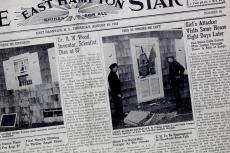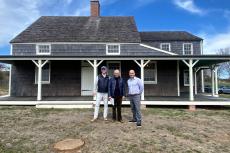Save Sag Harbor and a group of village residents scored a victory against the village this week when Justice Stephen Hackeling of Suffolk Supreme Court ruled in their favor, striking down two village laws that allowed for Adam Potter’s proposed 79-unit affordable housing and retail complex. Justice Hackeling agreed with the petitioners that the village had failed to comply with the New York State Environmental Quality Review Act (SEQRA) when it crafted the laws.
The two laws were passed on June 14, 2022; Mr. Potter filed his plans with the village that same day.
In the midst of the petition, Jeff Bragman and Claudia Braymer, the lawyers representing the plaintiffs, made a striking accusation against the village.
“The idea of the construction of a proposed affordable housing project to be located in the village’s office district at Bridge and Rose Streets was made known to the village board members in February 2022,” they wrote — months before the laws were enacted.
“They were aware of the project and failed to disclose that,” said Mr. Bragman, in a phone call. “They improperly segmented their review. They crafted a zoning law that was designed to accommodate this project, which ensured that certain issues weren’t going to get a detailed review, such as parking.”
Mr. Potter texted The Star Tuesday night, sounding confident that his project would yet happen. “When I started, I stated my intentions are to build a new theater, expand a park and provide the first affordable housing in Sag Harbor . . . I believe all three objectives can be achieved and am looking forward to working with the community and village leaders to make this happen.”
SEQRA is a process with detailed questions, forms, and timelines, which, when followed, succeeds in identifying the environmental ramifications of developments. A broad range of factors are considered during the process, including the character of a community, and not only clearly “environmental” aspects such as water and air quality.
“The village board adopted changes to the village code that create a material conflict with the village’s existing community plans and goals without undertaking a comprehensive planning process,” the petitioners’ lawyers wrote in the court filing.
Even apart from those arguments, the court agreed that the village had failed on procedural grounds alone to handle the SEQRA process properly.
Justice Hackeling focused on the “undisputed fact” that the village attorney, Liz Vail, had distributed a negative declaration of impact on the environment at the June 14, 2022, board meeting during which the trustees adopted the contentious legislation. Neither the public nor board members discussed the environmental impact at the time.
Though a “planning analysis” was included with the legislation when it was filed with New York State the following week, the judge commented that it should have been conducted prior to the June 14 negative declaration. Moreover, he noted, two parts of an environmental assessment form required for the SEQRA review were not signed by Mayor James Larocca until July, after the laws were passed.
“Clearly, the record in this indicates a de minimis, incomplete, environmental review was undertaken at the same time (if not after) the decision was made to adopt the subject Local Laws,” Justice Hackeling concluded. The SEQRA review, he wrote, needed to be done before the law was adopted.
“The Court notes that simultaneous negative declaration/local law adoption is becoming more popular and, in some instances, may meet SEQRA’s requirements. However, such a practice runs the risk that the cart is placed in front of the horse.”
The village had argued that the petitioners did not have “standing” to pursue their Article 78 challenge. Mr. Bragman pointed out that standing is rarely used in land-use cases.
To prove standing, according to a court document, the plaintiff “must show that it would suffer direct harm and injury that is in some way different from that of the public at large.”
The court determined that Laura Grenning, as a business owner and village resident, had standing. “As at least one petitioner has standing, all have standing to challenge the SEQRA determination of the subject Local Laws,” Justice Hackeling wrote.
“The fact that one person with standing was able to validate the others confirms a concern I had about this lawsuit from the beginning,” Mayor Larocca said in a phone call. “It’s not representative of any broad base in this community. These are all people living in million-dollar or more homes. They don’t represent some sort of grassroots segment of our community.”
“There’s no doubt in my mind that a broad base of our population wants us to do something about affordable housing. To be thwarted by such a narrow group is disappointing,” the mayor said, adding that the village will digest the news and consider its options.
“They could appeal it,” said Mr. Bragman, “but this would be a hard decision to win on appeal. There were procedural violations, and the rule on compliance for those, in regard to SEQRA, is much stricter.”
“We know that affordable housing is an urgent need in Sag Harbor. However, it is clear that the village cannot create a sensible affordable housing plan without taking the time to do a thorough comprehensive planning process with input from the whole community,” Save Sag Harbor said in a statement yesterday. “We continue to support other recent housing initiatives, including the accessory dwelling law that was passed together with Local Law 12, and the idea for housing at the firehouse site on Brick Kiln Road, put forward by Trustee [Tom] Gardella.”
Maziar Behrooz, a local architect who was among the petitioners, said this week that that far from being dead, the prospects for affordable housing were alive and well. “The community housing fund that was recently passed will provide unprecedented and decentralized opportunities for housing that could radically alter the housing landscape,” he said.




